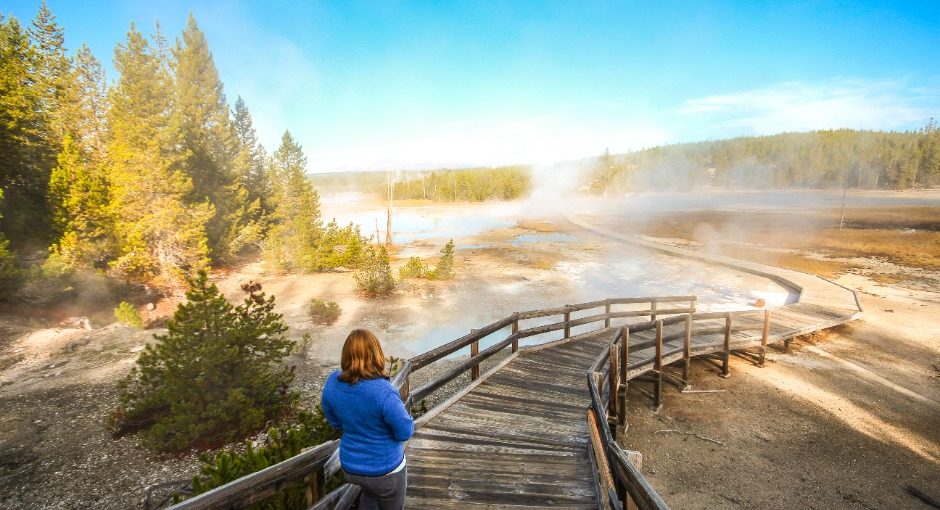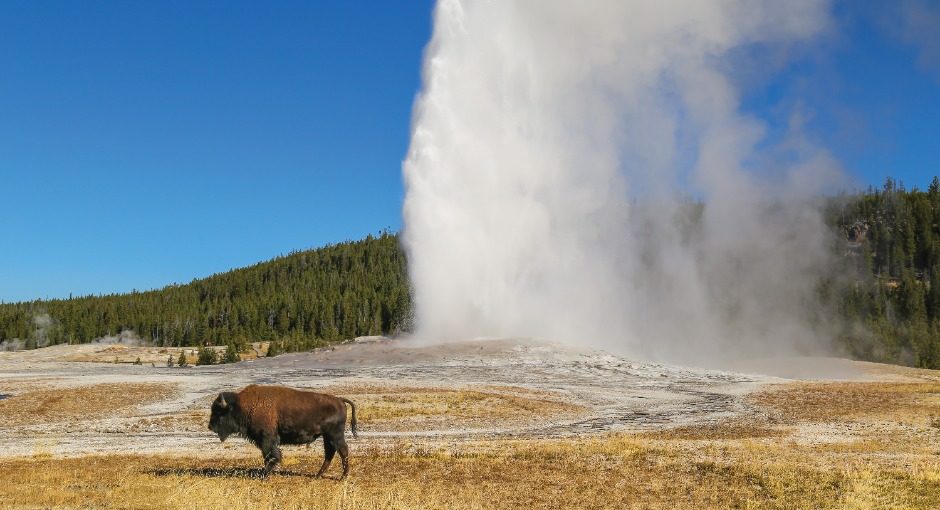How to Spend 1 Day in Yellowstone National Park
The Ultimate Day Trip to America’s First National Park
Yellowstone National Park was the United States’ first National Park and there’s a reason for it. Phenomenal wildlife, unique landscapes and one-of-a-kind geothermal features make up this massive National Park, and the truth is photos just can’t do it justice (and we’ve seen some spectacular photos of Yellowstone). Geysers spouting straight up next to steam vents and thermal features that seem like they belong on another planet. Muddy, bubbling cauldrons and emerald pools. Wildlife so majestic it will take your breath away. Yellowstone is a park that will steal your heart.
You could easily take two weeks to explore Yellowstone (and you might want to after you spend a day here). To truly experience the best aspects of the park, you’ll want to plan at least three days. But if you only have one day to spend in the park, you want to get the most out of your time here. The park is immense (nearly 3,500 square miles) with five entrances, and there’s lots to see. So we’re breaking it down into two separate travel itineraries designed to get you to the most memorable spots for scenery and wildlife.
The Upper Loop
This loop is easiest accessed by entering from West Yellowstone, MT or the Gardiner, MT entrance at the North. It features bubbling mud pools, multiple waterfalls, breathtaking canyons, hot springs and the best opportunities for viewing wildlife.
We’re giving you the list based on our favorite times of day to hit these locations, but you can start and stop anywhere along the loop and take as much or as little time as you’d like exploring.
HOT TIP: Start early. Sunrise in Yellowstone offers the most magical lighting as the sun peaks over the mountains, and provides a golden hour that is out of this world. Looking to stay overnight in a gateway town to get the earliest start possible? We love Gray Wolf Inn & Suites in West Yellowstone and The Ridgeline Hotel® at Yellowstone in Gardiner.
STOP #1 Artist Paintpots: This easy, one-mile hike meanders through a partially-burned lodgepole pine forest into a hydrothermal area featuring colorful hot springs, bubbling mudpots (watch out for flying mud), and small geysers. In the early morning, the steam from the springs and the rising sun create an epic display. The lower portion of this hike is wheelchair- and stroller-accessible which is perfect for families young and young at heart!
STOP #2 Grand Canyon of the Yellowstone: With views of Yellowstone Falls, pastel canyon walls, lodgepole pines and steam vents releasing steam among the canyon walls, this is a must-see spot in Yellowstone National Park. Take a breath as you take it in. This view often leaves first time visitors speechless.
STOP #3 Lamar Valley: Have your camera ready and binoculars handy. Lamar Valley is a prime spot for viewing the wildlife that Yellowstone is famous for. Herds of bison, wolf packs, elk, grizzlies and more roam this valley. If you’re extra lucky, you’ll get to hear the wolves howl, which we promise is an unforgettable sound that will give you chills.
HOT TIP: Although very early morning and dusk are the best times for wildlife viewing in this area, a visit at any time of the day will typically result in seeing wildlife of some sort.
STOP #4 Mammoth Hot Springs: Ever seen the inside of a cave, outside? That’s Mammoth Hot Springs.
Approximately 50 hot springs exist in this area, offering spectacular shades of white, tan and orange. Mammoth is completely different from other thermal areas in Yellowstone. There are two boardwalk paths to explore this area, and these cover about 1.75 miles of the Upper and Lower Terraces. With little elevation gain, this easy hike should take about an hour, but the sights surrounding you will stay with you forever.
STOP #5 Norris Geyser Basin: One of the largest thermal basins in Yellowstone, we love Norris Geyser Basin in the early evening. This popular spot can be crowded during peak daytime hours. But around dusk, the crowds diminish and this spectacular location offers stunning sunsets and phenomenal colors in both the sky and the landscape. This beautiful area also includes Steamboat Geyser, the world’s tallest active geyser. But only the very lucky catch this geyser erupting, as its eruptions are rare and infrequent.

Day Trip Itinerary: The Lower Loop
This loop is easiest accessed by entering from West Yellowstone, MT or the Jackson, WY entrance at the South. It features incredible geysers, the massive Yellowstone Lake, rainbow springs, mud volcanoes and lots of wildlife viewing.
STOP #1 Grand Prismatic Spring: This iconic spot is a must-see when visiting Yellowstone. This 160-foot deep hot spring is the largest in the United States and the third-largest in the world, but it’s the colors that keep people coming back in record numbers to experience it. To get here, head to Midway Geyser Basin, the earlier the better (these lots fill up fast). The boardwalk loop is wheelchair- and stroller-accessible (and little to no elevation gain). If you’re feeling adventurous, try the new Grand Prismatic Overlook trail which gives a fantastic view from above. Keep in mind it involves 105 feet of elevation gain and a 1.2 mile roundtrip hike.

STOP #2 Old Faithful: Erupting on schedule (give or take 10 minutes) 20 times per day, Old Faithful is undoubtedly the world’s most famous geyser. Old Faithful’s geyser viewing area (in the Upper Geyser Basin area) is very visitor friendly with bench seating, and lots of parking. However, expect crowds, especially during the summer months. Old Faithful eruptions vary in height from 100 to 180 feet and it’s quite remarkable to watch it go off, right on time.
HOT TIP: We love arriving in the morning hours, before noon. This typically means less crowds for viewing and a perfect spot to stop for lunch at the beautiful Old Faithful Inn. Looking for a souvenir of your experiences in Yellowstone? Yellowstone General Store is located here and they have tons of great Yellowstone mementos to take home with you.
STOP #3 Yellowstone Lake: Itching to visit the largest high elevation lake (above 7,000 feet) in North America? You’re in luck! Yellowstone Lake covers 136 square miles with over 110 miles of shoreline. There’s lots of stops along the way to view the lake from different vantage points, ending at Yellowstone Lake Hotel (it’s bright yellow and can’t be missed). It gets windy here, but on a clear day, there’s nothing more beautiful than this high-elevation lake surrounded by mountain peaks and lodgepole pine.

STOP #4 Mud Volcano: Mud geysers, mud cauldrons, a mud volcano and a storybook spring called Dragon’s Mouth are some of the one of a kind features you’ll experience during a stop at Mud Volcano. We should also mention you’ll experience some smells. Okay… lots of smells while you’re here. But it’s a one-of-a-kind location that feels like the polar opposite of your earlier visit to Grand Prismatic. Our favorite spot is Dragon’s Mouth, a cavern that spews steam out while the sounds of roaring waters might actually be a dragon hiding inside.
STOP #5 Hayden Valley: Teeming with wildlife, Hayden Valley sits at the heart of Yellowstone National Park. The Yellowstone River meanders through the valley, and on a clear day you can see for miles across the valley. Bison herds, elk, grizzly and black bears, fox and coyotes and more spend time in this valley. With lots of high spots with pull-outs along the road, there’s plenty of great spots to search for wildlife below.
HOT TIP: If you decide to hike this area, be sure you’re traveling with a group and have bear spray with you.
An Extraordinary Trip
One of our favorite things about Yellowstone National Park is the diversity. Every stop you make offers a completely new landscape, interesting thermal features and new wildlife. One visit will have you instantly understanding why this was America’s first National Park. And we’re pretty sure your first visit won’t be your last.



